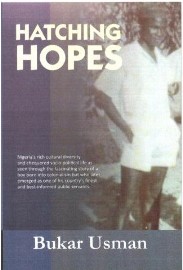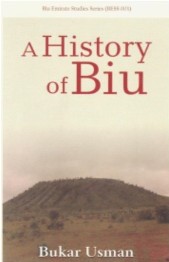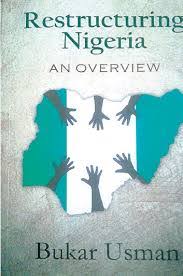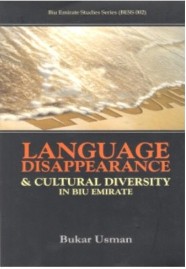| |
 Hatching Hopes portrays Nigeria’s rich cultural diversity and chequered socio-political life as seen through the fascinating story of a boy born into colonialism but who later emerged as one of his country’s finest and best-informed public servants. Hatching Hopes portrays Nigeria’s rich cultural diversity and chequered socio-political life as seen through the fascinating story of a boy born into colonialism but who later emerged as one of his country’s finest and best-informed public servants.
One of the unique qualities of this book is that it is an autobiography which also succeeds in being a public story. In telling his story, Bukar Usman at every stage refreshes for us the themes and major events of his time, thereby making this book a reflection of some key aspects of the multi-cultural and socio-political experiences of his country, Nigeria.
Aside from its public dimension, this book is a personal story of success achieved through exemplary discipline and dedication, and admirable focus and fortitude. From his early leadership roles as Borno College headboy, King’s College football star, and Ahmadu Bello University athlete, the author moved on to a distinguished career in the public service, rising to the position of Permanent Secretary in the Presidency, where he served for a period of 27 years. The author, thus, can be relied upon to intimate us with the intricacies of governance at different stages of the nation’s development and to shed light on various policy thrusts as he witnessed or paticipated in formulating or implementing them.
Remarkably, the hopes Dr. Usman ultimately hatched can be said to be, at the end of the day, more national than personal. And it is probably for this that he was honoured with the award of Officer of the Order of the Niger (OON).
Get a PDF copy here.
 History of Biu, 2015 Sun Non-Fiction Book of the Year, is Bukar Usman’s magnum opus on the city and emirate of Biu, an important melting pot in north-eastern Nigeria. Biu Emirate is noted for its ethnic and religious tolerance, a great quality in the strife-stricken, Boko Haram-troubled, north-eastern axis of Nigeria. History of Biu, 2015 Sun Non-Fiction Book of the Year, is Bukar Usman’s magnum opus on the city and emirate of Biu, an important melting pot in north-eastern Nigeria. Biu Emirate is noted for its ethnic and religious tolerance, a great quality in the strife-stricken, Boko Haram-troubled, north-eastern axis of Nigeria.
A History of Biu, the third in Dr Bukar Usman’s “Biu Emirate Studies Series,” is a 693-page book of historical narratives so well written and so maturely analytic every reader would pleasantly be carried away by the authenticity of its communal odysseys and the universal candour of its unique socio-cultural realities. Hailed as a notable contribution to Nigerian and African historiography, A History of Biu “paints a balanced picture of the multi-cultural Biu Emirate society and, through its portrayal of critical social phenomena, unveils the core values knitting together this tolerant centuries-old civilization.” Scores of colourful pictures complement this comprehensive document of immense value.
Get a PDF copy here.
|
|
 The debate about restructuring Nigeria has mainly been conducted in the media and in group-sponsored conferences. This book arguably marks the first time someone has documented the key points of the debate in a book form. The debate about restructuring Nigeria has mainly been conducted in the media and in group-sponsored conferences. This book arguably marks the first time someone has documented the key points of the debate in a book form.
In Restructuring Nigeria: An Overview, Dr Bukar Usman responds to some of the crucial questions raised by many stakeholders. Although some of the topical issues are controversial, he manages to conduct discussion about them in a cool-headed and mature way. He identifies over 30 contentious questions, logically countering them one after the other.
The book has five chapters. Chapter 1 is on due process of constitutional amendment while Chapter 2 takes up the lingering issues about the integrity of the 1999 Constitution. Chapter 3, the book’s longest, is where the author logically marshals his tightly-structured arguments in response to some of the contributions to the restructuring debate. In Chapter 4, the author wakes up the historian in him to enlighten readers on how Nigeria’s erstwhile regions worked in the 1960s and why they may not work again in like manner. The last chapter passionately presents the case for ethical restructuring of the country, highlighting it as a necessary compliment, if not the foundation, to any other form of restructuring.
Unlike many other contributors to this debate, Dr Usman consciously avoids name-calling and the use of intemperate language. His consistent focus on the issues and his reliance on facts and logical reasoning to buttress his arguments are some of the qualities that make this work a worthy and interesting book to read.
Get a PDF copy here.
 In his Biu Emirate Studies Series (BESS), Dr Usman, President of Folklore Society of Nigeria, redirects scholarly attention to the very fabric of Biu Emirate society – its people and culture, and then goes further to detect threats to their survival in our fast-changing world. This book, Language Disappearance and Cultural Diversity in Biu Emirate, is the second book in this series. Here, Dr. Usman explores the phenomenon of language disappearance around the world, pinning down the issues through a diachronic research into his multi-lingual Biu area in North-Eastern Nigeria. What emerges from his case-specific enquiry are not only frightening facts and figures portraying the stark realities of language endangerment but also learned pointers to effective ways of revitalizing and restoring threatened or even dying mother tongues. In his Biu Emirate Studies Series (BESS), Dr Usman, President of Folklore Society of Nigeria, redirects scholarly attention to the very fabric of Biu Emirate society – its people and culture, and then goes further to detect threats to their survival in our fast-changing world. This book, Language Disappearance and Cultural Diversity in Biu Emirate, is the second book in this series. Here, Dr. Usman explores the phenomenon of language disappearance around the world, pinning down the issues through a diachronic research into his multi-lingual Biu area in North-Eastern Nigeria. What emerges from his case-specific enquiry are not only frightening facts and figures portraying the stark realities of language endangerment but also learned pointers to effective ways of revitalizing and restoring threatened or even dying mother tongues.
The importance of this study is underscored by Professor of Linguistics Andrew Haruna: “The languages of the Biu-Mandara (Central Chadic) sub-branch of the Chadic family are mainly found in the Biu Emirate… Apart from Babur/Bura, Marghi, Kanakuru, Kibaku (Chibok), most of the languages of the area are spoken by few thousand speakers and the languages are generally not being passed down to children…the book contributes to the discussion leading to an enhanced understanding of the actual situation of language endangerment in the Biu Emirate which Dr. Usman being Babur/Bura himself brought to the fore.” According to Prof. Chinyere Ohiri, former President of Linguistic Association of Nigeria, Dr Usman’s Language Disappearance and Cultural Diversity in Biu Emirate is “a book that…takes the issue of language endangerment seriously (and) has done so from the firsthand experience of its author… The book provides a potent case study of… numerous minority languages…chronicling some of the historical, socioeconomic, political and educational factors that have steadily led these languages to the path of endangerment and possible extinction.”
Get a PDF copy here.
|
|
 Hatching Hopes portrays Nigeria’s rich cultural diversity and chequered socio-political life as seen through the fascinating story of a boy born into colonialism but who later emerged as one of his country’s finest and best-informed public servants.
Hatching Hopes portrays Nigeria’s rich cultural diversity and chequered socio-political life as seen through the fascinating story of a boy born into colonialism but who later emerged as one of his country’s finest and best-informed public servants. History of Biu, 2015 Sun Non-Fiction Book of the Year, is Bukar Usman’s magnum opus on the city and emirate of Biu, an important melting pot in north-eastern Nigeria. Biu Emirate is noted for its ethnic and religious tolerance, a great quality in the strife-stricken, Boko Haram-troubled, north-eastern axis of Nigeria.
History of Biu, 2015 Sun Non-Fiction Book of the Year, is Bukar Usman’s magnum opus on the city and emirate of Biu, an important melting pot in north-eastern Nigeria. Biu Emirate is noted for its ethnic and religious tolerance, a great quality in the strife-stricken, Boko Haram-troubled, north-eastern axis of Nigeria. The debate about restructuring Nigeria has mainly been conducted in the media and in group-sponsored conferences. This book arguably marks the first time someone has documented the key points of the debate in a book form.
The debate about restructuring Nigeria has mainly been conducted in the media and in group-sponsored conferences. This book arguably marks the first time someone has documented the key points of the debate in a book form. In his Biu Emirate Studies Series (BESS), Dr Usman, President of Folklore Society of Nigeria, redirects scholarly attention to the very fabric of Biu Emirate society – its people and culture, and then goes further to detect threats to their survival in our fast-changing world. This book, Language Disappearance and Cultural Diversity in Biu Emirate, is the second book in this series. Here, Dr. Usman explores the phenomenon of language disappearance around the world, pinning down the issues through a diachronic research into his multi-lingual Biu area in North-Eastern Nigeria. What emerges from his case-specific enquiry are not only frightening facts and figures portraying the stark realities of language endangerment but also learned pointers to effective ways of revitalizing and restoring threatened or even dying mother tongues.
In his Biu Emirate Studies Series (BESS), Dr Usman, President of Folklore Society of Nigeria, redirects scholarly attention to the very fabric of Biu Emirate society – its people and culture, and then goes further to detect threats to their survival in our fast-changing world. This book, Language Disappearance and Cultural Diversity in Biu Emirate, is the second book in this series. Here, Dr. Usman explores the phenomenon of language disappearance around the world, pinning down the issues through a diachronic research into his multi-lingual Biu area in North-Eastern Nigeria. What emerges from his case-specific enquiry are not only frightening facts and figures portraying the stark realities of language endangerment but also learned pointers to effective ways of revitalizing and restoring threatened or even dying mother tongues.